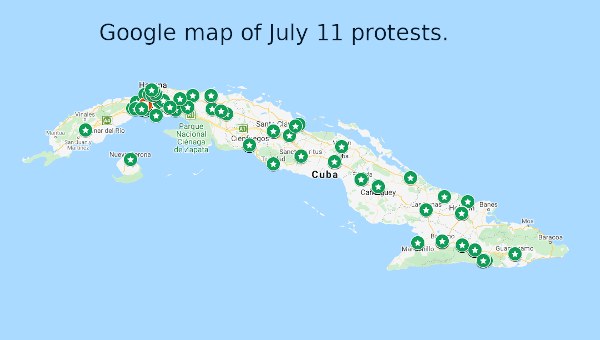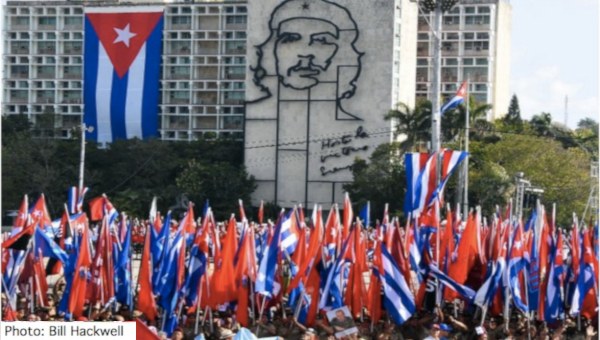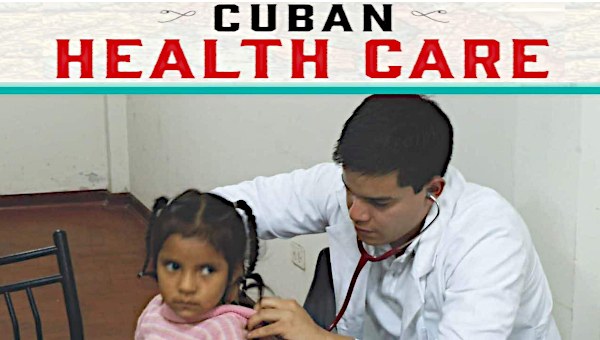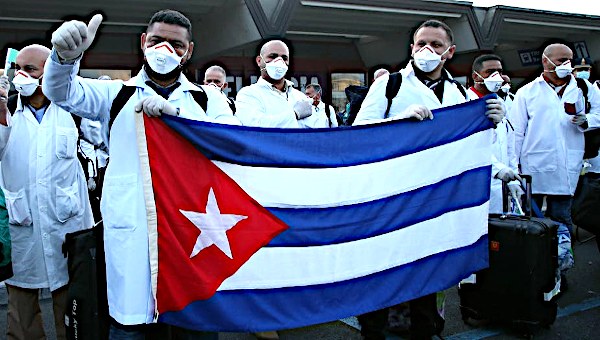The Road Ahead: Cuba After the July 11 Protests
The Bullet is pleased to present the preface and the first essay of the symposium “The Road Ahead: Cuba After the July 11 Protests,” edited by Philip Brenner, John Kirk, and William LeoGrande. We thank the editors for granting us permission to do so.
The Road Ahead, or the “virtual Symposium” as the editors call it, is a large and ambitious work, organized to engage readers whose knowledge of Cuba ranges from limited to expert. Its approach is inclusive, providing space for a variety of viewpoints. The editors have been careful to provide a representative sample of the discussion and debate among Cubans over how best to deal with the immense challenges that their country faces. The July 11 protests have highlighted the urgency of dealing with these issues. The positions of the Cuban government as well as those of Washington are well documented in the work.
We are only able to provide here a small sample of the wealth of ideas contained in the virtual Symposium. Readers who visit the home page of The Road Ahead and use the links there to explore the material in more depth will be well rewarded.
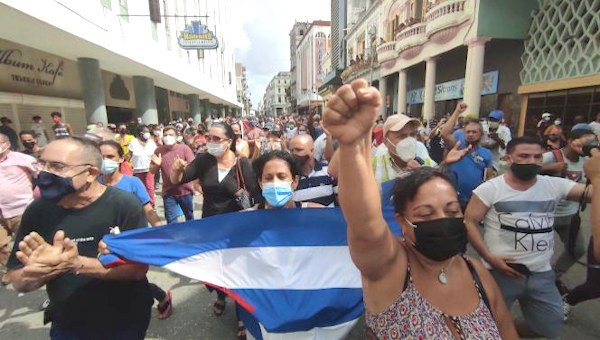
Preface
Fifteen months before the island-wide protests that rocked Cuba on July 11, 2021, Rowman and Littlefield published Cuba at the Crossroads, which we edited. The book explored several challenges the country was facing – though at the time of writing COVID-19 was not among them – and anticipated that change would be inevitable. Contrary to a common narrative that Cuba is mired in the twentieth century unable to adapt to new circumstances, Cuba at the Crossroads highlighted changes that had occurred in the six years since we had edited A Contemporary Cuba Reader: The Revolution under Raúl Castro. But most observers did not appreciate how angry many Cubans have become over the slow pace of change and the government’s seeming lack of understanding of the suffering Cubans were experiencing. The unprecedented outpouring of protests on July 11 surprised analysts and even the protest organizers themselves.
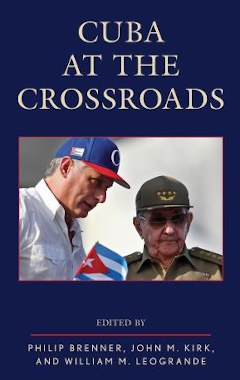
The July 11th demonstrations elicited a variety of analyses and commentaries that have attempted to explain the significance of events that day. Were these protests a sign that the revolutionary government was widely unpopular with the Cuban masses? Was this the harbinger of a Cuban version of the Arab Spring? Were we witnessing profound social change, or temporary frustration in the face of an ongoing pandemic and food shortages? Or was this merely the result of US manipulation of social media?
As long-time observers of Cuban politics and history, we were immediately aware of the significance of events that day. July 11 was more than just a single day of protests, but instead signaled major challenges for the Cuban revolutionary process. As a result, we invited some of the foremost Cuba specialists from various countries to offer their interpretations of the meaning of “11-J,” as it is widely known. Our objective is to provide an empirically and analytically grounded account of these unprecedented protests.
This virtual Symposium presents a series of essays examining key aspects of the events that day, reviewing the various background conditions, and contributing factors that led to the protests. Together they help to complete the picture of what occurred that day, why it happened, and what it may portend for the future.
The Symposium consists of several components, beginning with the original invited contributions. The Additional Analysis section includes links to some of the most insightful reflections on 11-J published elsewhere, many of them by Cubans on the island, representing a range of viewpoints. This is followed by the Further Readings section which provides links to a wide variety of statements and analyses on 11-J, including statements from the US and Cuban governments, third countries and international organizations, as well as analyses by independent commentators.
Finally, we would like to express our appreciation to our contributors who crafted in-depth analyses in record time, and to American University’s Center for Latin American and Latino Studies for hosting this symposium. •
Introduction: Setting the Context
Abstract: This introduction describes the context in which the July 11th protests occurred. It identifies the main reference point for most Cubans as the “Special Period” of the 1990s, and describes the “perfect storm” of circumstances that led so many Cubans to take to the streets. Finally, it poses the question of whether July 11th is an inflection point in the development of the Cuban Revolution.
__________
It would be difficult to find a Cuban who is unaware of the protests that rocked the country on July 11, 2021. Unlike demonstrations in 2020 by artists and writers, the mid-July demonstrations took place throughout the country, not only in Havana. While the artists and writers’ objectives were important – they sought fewer restrictions on public expression – these were not the primary concerns of the vast majority of the populace. In contrast, the demands of the July protestors focused on a broad range of grievances that had been festering for years. To some, the protests even seemed to challenge the very legitimacy of the government. Indeed, in the afternoon of July 11, President Miguel Díaz-Canel went on national television denouncing the protestors and calling on “revolutionaries” to confront those involved in the “provocations.”1 Cuba had not experienced such widespread and intensely-felt demonstrations since the overthrow of Fulgencio Batista’s dictatorship 62 years earlier.
This introduction will provide a brief history of circumstances that contributed to July 11, which historian Jésus Arboleya aptly described as “the perfect storm.”2 That context alone does not explain why the one-day explosion occurred – the articles in this Symposium probe particular factors that enable a reader to develop a fuller analysis. Still, the context is a starting point for such an analysis.
Points of Reference
The Special Period
Prior to 1989, 85 percent of Cuba’s trade occurred with countries in the Soviet Union’s trading bloc, the Council of Mutual Economic Assistance (CMEA), often with barter-like arrangements. When the CMEA collapsed and Soviet subsidies ended, Cubans experienced what President Fidel Castro called “a special period in a time of peace.” Between 1989 and 1993, Cuba’s economy and international trade declined by 35 and 80 percent, respectively; 50,000 Cubans temporarily lost their eyesight because of vitamin deficiencies; and by 1993 the average daily caloric intake in Cuba had fallen below the World Health Organization standard.3
The Special Period is the initial point of reference for a majority of Cubans, most of whom have little or no memory of life before the 1990s when racial and gender disparities were disappearing and most people could reasonably hope that their children’s lives would be better than their own. In contrast, their vivid memory of the Special Period is one of a daily struggle for survival and suffering. Notably, as sociologist María del Carmen Zabala explained, “poverty reemerged as a social problem, and, consequently, the thesis that poverty was being eradicated in Cuba… began to be questioned”.4 The government’s response to the dire circumstances – legalizing the US dollar, permitting some small private businesses to open, encouraging foreign investment and re-building the tourist industry – stopped the economy’s free fall and enabled it to provide a basic social safety net. But the resulting dual currency system, reliance on remittances, and the breakdown of the previous egalitarian reward system brought about significantly greater inequality.
Anthropologist Hope Bastian reports that inequality not only created gaps in consumption. It altered social relations as local community ties began to disintegrate, which in turn generated new patterns of social stratification.5 Importantly, economic differences emerged “along clearly visible racial lines,” as sociologist Katrin Hansing observed.6 A greater proportion of darker-skinned than lighter-skinned Cubans were living in substandard housing, which made them unsuitable for rent to tourists, depriving them of one source of hard (internationally accepted) currency. Darker-skinned Cubans also lacked access to capital from remittances and suffered discrimination due to racist norms in hiring for the tourism industry. Most members of the Cuban diaspora were white, and sent remittances to family members, also white. Inequality and scarcity also contributed to Cubans’ changing values as they came to place a greater emphasis on materialism and individualism.
In an attempt to stuff the genie back in the bottle in the early 2000s, the government reversed several of the mid-1990s economic reforms that officials considered were sources of the problems of inequality and racial disparities. For example, as a way of gaining control over the use of hard currency, the government decreed that Cubans had to use a newly created convertible peso instead of US dollars. It also attempted to decrease legal self-employment by limiting the number of new licenses it granted and even withdrawing some existing ones.7 The reversals generated a new cynicism about the government’s commitment to reform. Moreover, the measures did little to address the problems, because Cuba continued to rely on tourism and remittances to generate hard currency, which were the main contributors to inequality.
Meanwhile, a greater openness created new spaces for expression and enabled public criticism to flourish. For example, Temas magazine expanded the borders of what was acceptable by publishing articles on topics rarely covered in the official media, and with views well outside the mainstream. Two other magazines sponsored by the office of the Archbishop of Havana – Palabra Nueva and Espacio Laical – also provided venues for open debate. Similarly, popular Cuban hip-hop artists focused on the problems of daily life. The music provided a way for the generation of the 1980s and 1990s “to speak out about racism, prostitution, police harassment, growing class differences, the difficulty of daily survival, and other social problems of contemporary Cuba,” sociologist Margot Olavarria observed.8
Until the Special Period, the Cuban Institute of Cinematographic Art and Industry (ICAIC) was the only distributor of Cuban films and provided most of the support for production. However, as resources for film making shrank, the government permitted filmmakers to obtain funding outside of the country. Coproduction gave them the opportunity to explore subjects previously taboo in Cuba. This was apparent in the 2010 to 2013 period, with films such as Revolución (2010) on underground culture, Habanastation (2011) on inequality, and Melaza (2012) on the necessity to engage in petty corruption in order to survive. Cuba’s first “zombie” movie, Juan de los Muertos (2011), satirized government attempts to cover up the existence of the living dead by alleging they were dissidents trying to overthrow the revolution.
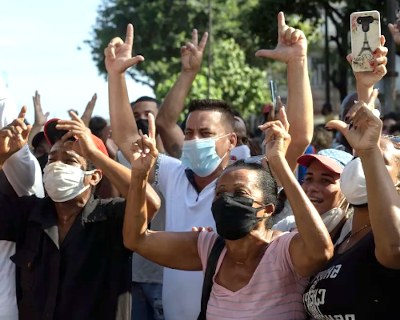
A New Era
On July 31, 2006, a gravely ill Fidel Castro handed his conductor’s baton to Raúl Castro. When the younger brother of Cuba’s larger-than-life revolutionary leader accepted the provisional reins of power as head of state and commander-in-chief of the Revolutionary Armed Forces, a new era began in Cuba. Cubans had demonstrated a remarkable resilience and ability to adapt during the Special Period, but the new president could not be certain how much longer they would be patient. Their suffering had taken an enormous toll. The wellspring of hope that had nurtured Cubans’ belief in the future, which had given them the energy and strength to defy the odds in building a new society, seemed depleted. Increasing inequality, decreasing access to health care and a good education, and a declining sense of communal solidarity had eroded distinctive aspects of the Cuban Revolution.
Raúl Castro proceeded cautiously at first, making no dramatic moves. Yet he also began to prepare the country for what he hoped would be a reinvented Cuban revolution. In July 2007, in the president’s annual address commemorating the 1953 Moncada attack, he departed from his brother’s usual focus on the US embargo as the source of Cuba’s problems. The main issue, he declared, was that “No one, no individual or country, can afford to spend more than what they have….To have more, we have to begin by producing more, with a sense of rationality and efficiency, so that we may reduce imports, especially of food products….” Then he warned that to achieve this goal “structural and conceptual changes will have to be introduced.”9
What followed in the next five years were a series of reforms that Cubans anticipated would create a vibrant non-state sector of the economy and improve living standards. In 2008, the government began to issue licenses that allowed drivers to use private cars as taxis, and it lifted the ban on selling computers, DVD players, and cell phones. Two years later, the president announced a plan to reduce the size of the state’s workforce by nearly twenty percent. The government was strapped for cash to pay workers, and officials reasoned that some laid-off state workers might accept the government’s offer of up to forty hectares of free land on which they could increase domestic food production. A strong negative reaction from the public and state managers led Castro to reverse himself in August 2010, saying that reductions in the state workforce would come mainly from attrition. He then pressed senior officials to quicken the pace of change, a process he subsequently labeled as “updating the Cuban economic model.”10
The most important feature of the update was a set of “Guidelines for the Economic and Social Policies of the Party and the Revolution,” known as Lineamientos.11 After a nationwide debate and major revisions, in 2011 the Cuban Communist Party approved 313 Lineamientos, which established a process for expanding the number of permissible private (referred to as “non-state”) sector enterprises. The list included mostly service jobs, such as barber, beautician, electrician, bricklayer, plumber, photographer, waiter, truck driver, flower seller, entertainer, sports instructor, and so on.12
Still, the Lineamientos provided a new orientation for the society. Previously, as Cuban analyst Juan Triana explained, the country’s leaders asserted that “socialism was the guarantor of achieving development.” In contrast, the new view held “that without development it will be very hard to sustain Cuban socialism.” Moreover, “development” would mean a greater reliance on market factors in determining wages and even what enterprises produced.13 (Notably, the 2019 constitution recognizes private ownership of productive as well as personal property, and guarantees that foreign investment is an “important element for the economic development of the country.”14)
Economist Jorge Mario Sánchez aptly observed that the economic changes “pointed in the right direction but were insufficient to deal with the roots of dysfunctionality.”15 Cuba still had not found a way to generate enough hard currency to develop a sustainable and equitable economy. While its Gross Domestic Product had reached $100-billion by 2013, hard currency earnings amounted to only 4 percent of the total, and too much of that was spent on food. Cuba was importing about 70 percent of its food.16 Given its access to fish and an abundance of arable land, it should have been able to produce about that percentage domestically. A poignant film released in 2014, Canción de Barrio, about concerts that Silvio Rodríguez gave in marginal barrios of Havana, highlights significant social problems seven years ago. Given the economic downturn, aggressive policies of both the Trump and Biden administrations, continued bureaucratic mismanagement of key production sectors, the virtual disappearance of tourism, and the COVID pandemic, life has not improved in the barrios. Notably, the Cuban government re-released the film in early October, in effect acknowledging the legitimacy of some of the July 11th protestors’ criticisms.
The Perfect Storm
By 2018, when Miguel Díaz-Canel was elected as Cuba’s new president, the country had experienced considerable change. The number of small businesses had increased substantially; greater freedom of expression contributed to an explosion of new films, music, art, literature, and commentary; international engagement – especially the opening to the United States in 2015 – created several new opportunities for development; eased travel restrictions enabled Cubans to work abroad and retain their property and rights on the island; and the internet was becoming widely available. Yet the economy was stagnating, poverty was on the rise, and inequality had increased from a Gini Index of 0.24 in 1986 to 0.45 in 2017.17 The most significant economic reforms remained in their planning stages, Venezuela could no longer provide the same amount of low-priced oil, and so Cuba’s ability to generate sufficient hard currency from sources other than tourism and remittances was even more problematic than it had been in 2013.
In the next three years, Cuba’s problems only deepened. Arch-conservative governments in Brazil, Ecuador, and Bolivia ended programs involving Cuban medical personnel, which resulted in Cuba losing more than one-half billion dollars. In 2018 and 2019 economic growth was anemic, which is incompatible “with a sustained improvement in the living conditions of a majority of Cubans,” as Ricardo Torres argued.18 Moreover, a drop of foreign currency earnings starting in late 2018 resulted in a significant shortage of basic necessities, including chicken, eggs, rice, beans, and hygienic products such as soap and toothpaste.
In response to the coronavirus pandemic, Cuba closed its doors to all foreign visitors. In 2020, Gross Domestic Product declined by 11 percent. By closing the island to visitors and taking preventive measures, Cuba weathered the pandemic fairly well in 2020. But shortly after it opened again to foreign visitors in late December 2020, the cases of COVID-19 began to soar. Consider that there were only 35 cases detected on November 25, 2020, and 9,907 on just one day in late August 2021.19 Hospitals were incapable of handling the influx of patients, and basic medical supplies were widely unavailable. On February 1, 2021 there were still only 6,337 total active cases in the country, though the weekly increase was 25 percent. Six days before the July 11th protests, the weekly accounting was up by 45 percent, with 30,840 active cases in the country. Deaths were also rising dramatically. In the week prior to July 5, there had been 122 deaths attributed to the virus. The next week there were 384.20 Cuba was quickly becoming the country with the worst COVID-19 rate in the Western Hemisphere.
These circumstances coincided with President Donald Trump’s decision to roll back most of President Barack Obama’s executive orders relaxing US sanctions. New regulations reduced the amount of remittances Cuban-Americans could send to their families – these had accounted for one-third of Cuba’s hard currency earnings – and later forced the closure of Western Union’s operations in Cuba, which had been the principal conduit for remittances. Trump restrictions also reduced by more than half the number of US visitors to Cuba prior to the onset of the pandemic. In a final blow in early 2021, the Trump State Department returned Cuba to its list of state sponsors of terrorism, which further hampered Cuba’s ability to engage in international financial transactions.
US sanctions not only deprive Cuba of hard currency. They significantly increase the cost of buying basic medicines and even simple devices such as syringes to administer the COVID-19 vaccine the country developed. Consider that after President Gerald Ford modified the embargo in 1975 to allow US corporations in third countries to sell goods to Cuba, food and medicine made up 91 percent of Cuba’s purchases from these companies.21 But a 1992 US law ended that relaxation in the embargo. It also restricted ships that visited Cuban ports from docking in the United States for a period of six months. Cuba rarely can purchase a full shipload of goods. As a consequence, the cost of importing food and chemicals is high because these ships travel only partially full.
Meanwhile, the United States stepped up its efforts to instigate protests and disruptions. Under circumstances where Cuba was not struggling with multiple challenges, US support for internal opponents might have had little impact. Indeed, in 2010 the US Agency for International Development failed in an attempt to create a Twitter-like network in Cuba called ZunZuneo. It was intended to stimulate flash mobs of the sort that led to the 2011 Arab Spring. But in the context of a perfect storm, the annual $20-million “democracy promotion” program undoubtedly contributed to the level of protests.22 These projects continue today, well into the Biden administration.23 In addition, so-called “influencers” in Florida had an impact. Funded in part by conservative exiles, these commentators and hip-hop artists were empowered by Cubans’ newfound access to the internet. For example, the professional quality music video, “Patria y Vida,” which became the anthem of the July 11 protestors, was produced in Miami in February 2021.24 Reuters journalist Sarah Marsh reports that the initial protest in the town of San Antonio “was convened online by… the Facebook group ‘City of Humor,’” which is administered in Miami.25
The Cuban government’s immediate response to the protests only fueled the demonstrators’ anger. Focusing on the few who were violent, ignoring police violence against peaceful protestors, and dismissing legitimate grievances, Díaz-Canel described demonstrators as “mercenaries, lackeys of the Yankee empire.” He blamed most of Cuba’s problems on the United States, and called “on all revolutionaries in our country, all communists, to take to the streets in any of the places where these provocations may take place today, from now on, throughout these days.”26 On July 14, Díaz-Canel did soften his remarks, recognizing that a lack of attention and sensitivity “by our institutions” to the population’s “problems” contributed to widespread dissatisfaction.27 Still, as former Cuban ambassador Carlos Alzugaray observed, the government’s reaction lacked credibility and Cubans viewed it as “an effort to cover up its own errors. What the regime has underestimated is the dissatisfaction that this mantra [blaming the United States for Cuba’s problems and belittling the sincerity of most demonstrators] now provokes.”28
An Inflection Point?
In the immediate aftermath of the July 11 protests, the editors of this Symposium were flooded with blogs, articles, and email commentary from the world over, and especially from Cuba. We were surprised by both the openness of criticisms and the anguish and anger some expressed. Consider this private correspondence from a colleague who had believed deeply in and had devoted a lifetime working tirelessly for the goals of the Cuban Revolution:
“My main problem and concern is the stupid and terrible behavior of the Cuban Government itself… Since the approval of the new Constitution in 2019, the need to create norms, which translate the rights into real practice, has been delayed. With no strategic vision, and maybe some disdain, all the new measures have negatively affected ordinary Cubans… Another long-delayed measure, the Tarea Ordenamiento, was supposed to eliminate the dual monetary system. Instead, they created special stores in which you can buy goods only with a hard currency bank card, not with Cuban pesos, not the result of honest work. For years, and particularly since the crisis of the 90’s, class differences, inequalities and niches of real poverty have been a constant, but nobody listens. Now the Pandemic has revealed even more inequalities and distress.”
Since July 11, there have been only a few isolated and peaceful demonstrations. The question thus arises, whether July 11 was an inflection point, an important moment in the development of the Cuban Revolution that will signify for Cubans a meaningful point of departure. One indication that it is an inflection point has been the Cuban government’s response. In the harshness of their crackdown against so many protestors, Cuban officials acted as if they viewed July 11 as a pre-revolutionary situation. At the end of September, according to some nongovernmental organizations, more than five hundred demonstrators remain in prison, and some have been forced to leave the country. As of this writing, the government has formally sentenced 67 protestors to prison, all for crimes of violence or the destruction of property.29
The government also reacted positively by announcing that state salaries would be increased. In addition it suspended tariffs for goods that visitors bring into the country, and announced it was developing a plan to increase energy production in order to reduce or eliminate blackouts. But such nods to the legitimacy of the protests may be too little and too late. Already some protestors have formed themselves into a nationwide organization called Grupo Archipiélago. In September 2021 it requested permits for peaceful rallies to be held on November 20, 2021 in several cities.30 After the government announced that it would engage in a series of annual defense activities, culminating on November 19, opposition groups changed the date for the protests to November 15. On October 12, municipal authorities from the cities where the demonstrations are scheduled denied permission for the march permits, stating that “the announced march… constitutes a provocation as part of the strategy of ‘regime change’ for Cuba, which has been tried out in other countries.”31
Even though circumstances continue to change rapidly in Cuba, knowledgeable observers have had the benefit of four months to reflect on the meaning and importance of the July 11 protests. We have assembled a set of articles written expressly for this Symposium analyzing factors that engendered the demonstrations and which can also provide a basis for assessing the future course of the Cuban Revolution. In addition, we offer readers links to a set of materials that complement the essays in this symposium from more than three hundred items we reviewed. These include especially thoughtful pieces assessing the causes and meaning of the protests, most written by authors living on the island, as well as documents and official statements from Cuba, the United States, China and countries in Europe. •
This article first published in the virtual symposium, “The Road Ahead: Cuba After the July 11 Protests.”
Endnotes
- Marc Frank and Sarah Marsh, “Cuba sees biggest protests for decades as pandemic adds to woes,” Reuters, July 12, 2021. William M. LeoGrande, “Cuba’s Protests Are Different This Time,” The Nation, July 13, 2021.
- Jésus Arboleya, “The Perfect Storm,” Progreso Weekly, July 28, 2021.
- Katherine Tucker and Thomas R. Hedges, “Food Shortages and an Epidemic of Optic and Peripheral Neuropathy in Cuba,” Nutrition Reviews, vol. 51, No. 12 (1993), pp. 349–357; Jorge I. Domínguez, “Cuba’s Economic Transition: Successes, Deficiencies, and Challenges,” in The Cuban Economy at the Start of the Twenty-First Century, ed. Jorge I. Domínguez, Omar Everleny Pérez Villanueva, and Lorena Barberia (Cambridge, MA: Harvard University Press, 2004), 19.
- María del Carmen Zabala Argüelles, “Poverty and Vulnerability in Cuba Today,” in A Contemporary Cuba Reader: The Revolution Under Raúl Castro, eds., Philip Brenner, Marguerite Rose Jiménez, John M. Kirk, and William M. LeoGrande (Lanham, MD: Rowman and Littlefield, 2014), 192.
- Hope Bastian, Everyday Adjustments in Havana: Economic Reforms, Mobility, and Emerging Inequalities (Lanham, MD: Lexington, 2018), Chapters 2-3.
- Katrin Hansing, “Race and Inequality in the New Cuba: Reasons, Dynamics, and Manifestations,” Social Research: An International Quarterly, 84:2 (Summer 2017), 331.
- Mauricio de Miranda Parrondo, “The Cuban Economy: Amid Economic Stagnation and Reversal of Reforms,” in A Contemporary Cuba Reader: Reinventing the Revolution, eds., Philip Brenner, Marguerite Rose Jiménez, John M. Kirk, and William M. LeoGrande (Lanham, MD: Rowman and Littlefield, 2007), 134.
- Margot Olavarria, “Rap and Revolution: Hip-Hop Comes to Cuba.”
- Raúl Castro Ruz, “Speech at the Celebration of the Attack on Moncada.” Camaguey, July 26, 2007; accessed September 21, 2021 at granma.cu.
- Raúl Castro Ruz, “Speech during the closing ceremony of the Sixth Session of the Seventh Legislature of the National People’s Power Assembly,” December 18, 2010; accessed September 22, 2021 at cuba.cu.
- Sixth Congress of the Communist Party of Cuba, “Resolution on the Guidelines of the Economic and Social Policy of the Party and the Revolution,” April 18, 2011, accessed September 23, 2021 at cuba.cu.
- Richard E. Feinberg, Open for Business: Building the New Cuban Economy (Washington, DC: Brookings Institution Press, 2016), 140.
- Juan Triana Cordoví, “Moving from Reacting to an External Shock toward Shaping a New Conception of Cuban Socialism,” in No More Free Lunch: Reflections on the Cuban Economic Reform Process and Challenges for Transformation, eds, Claus Brundenius and Ricardo Torres Pérez (Heidelberg: Springer, 2014), 234.
- Constitución de la República de Cuba, Articles 22 and 28; accessed September 23, 2021 at presidencia.gob.cu.
- Jorge Mario Sánchez Egozcue, “Challenges of Economic Restructuring in Cuba,” in Brenner, et al, A Contemporary Cuba Reader (2014), 129.
- Ricardo Torres Pérez, “Concluding Reflections of the Current Reform Process in Cuba,” in Brundenius and Torres Pérez, No More Free Lunch, 225.
- Ricardo Torres, “Cuba’s Economy: Reforms and Delays, 2014-2018,” in Cuba at the Crossroads, eds., Philip Brenner, John M. Kirk and William M. LeoGrande (Lanham, MD: Rowman and Littlefield, 2020), 56.
- Torres, “Cuba’s Economy,” 47.
- Data found at COVID-19 Data Repository by the Center for Systems Science and Engineering (CSSE) at Johns Hopkins University. Accessed September 30, 2021 at github.com.
- World Health Organization, “Coronavirus disease (COVID-19) pandemic: Countries: Cuba.” Accessed September 26, 2021 covid19.who.int.
- Donna Rich Kaplowitz, “US Foreign Subsidiary Trade with Cuba: Before and After the Cuban Democracy Act,” in Cuba in the International System: Normalization and Integration, eds., Archibald R.M. Ritter and John M. Kirk (London: Palgrave Macmillan, 1995).
- Knight Lab, “Guerra Digital en Cuba,” Knight Lab, Northwestern University, August 21, 2021; accessed September 26, 2021 at knightlab.com. Also see: Ronald Suárez Rivas, “Dos meses de feroz ataque digital de EE. UU. contra Cuba,” Granma, August 30, 2021; accessed September 26, 2021 at granma.cu.
- US Agency for International Development, “Notice of Funding Opportunity Number: 7200AA21RFA00024 – Supporting Local Civil Society and Human Rights in Cuba,” June 30, 2021; accessed September 20, 2021 at govshop.com. Also see: Tracey Eaton, “NED failed to disclose 21% of Cuba grants,” Cuba Money Project, March 9, 2021; accessed September 26, 2021 at cubamoneyproject.com.
- Max Blumenthal, “Cuba’s cultural counter-revolution: U.S. gov’t backed rappers, artists gain fame as ‘catalyst for current unrest,’” MR Online, August 3, 2021; accessed September 19, 2021 at mronline.org. Notably the June 30 USAID Notice of Funding Opportunity (p. 4) lauded “Patria y Vida” as “as a rallying cry for change on the island.”
- Sarah Marsh, “The Facebook Group That Staged First in Cuba’s Wave of Protests,” Reuters, August 9, 2021; accessed September 20, 2021 at usnews.com.
- As quoted in Gladys Leydis Ramos López and Juan Diego Nusa Peñalver, “We defend the Revolution, above all else,” Granma (English edition), July 12, 2021; accessed on September 26, 2021 at granma.cu.
- Yaditza del Sol González y Gladys Leidys Ramos López, “Díaz-Canel: Hacemos un llamado a que el odio no se apropie del alma cubana, que es de bondad,” Granma, July 14, 2021.
- Carlos Alzugaray, “It’s not just the US embargo,” International Politics and Society, August 23, 2021; accessed on September 26, 2021 at ips-journal.eu.
- Nora Gámez Torres, “Cuban artist freed from jail, forced into exile. Other protesters face harsh sentences,” Miami Herald, September 27, 2021; accessed September 28, 2021 at miamiherald.com.
- “Cuban activists ask government for authorization to carry out ‘peaceful and civic’ march,” OnCubaNews English, September 27, 2021; accessed September 27, 2021 at oncubanews.com.
- “Es ilícita la marcha con fines desestabilizadores convocada en Cuba,” Granma, October 12, 2021; accessed October 12, 2021 at granma.cu. [Translation by Philip Brenner.]


